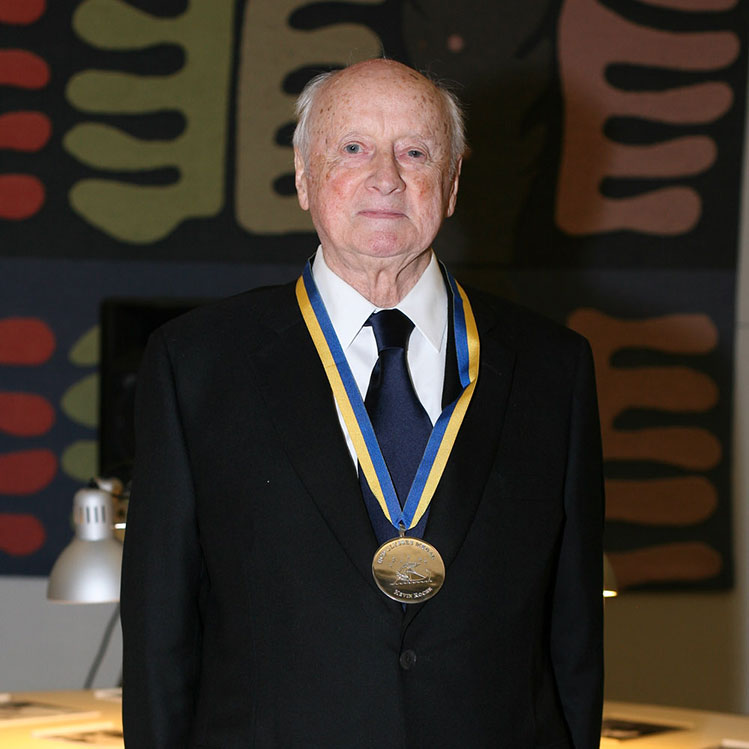In Memoriam Kevin Roche: 1922 - 2019
Posted 4 March, 2019
Born in Dublin in 1922, Kevin Roche grew up in Mitchelstown Co. Cork, where his father managed the sizeable local creamery, and where the young Roche, years later as an architecture student at UCD in the mid-1940s, designed his first building: a piggery, shaped out of concrete blocks. It was not until 1998 that Roche came to design his second Irish building, the Conference Centre on Dublin’s River Liffey (complete in 2008). At that stage, though semi-retired, Roche was still heading up a vibrant architectural practice in New Haven, USA and importantly, having won the 1982 Pritzker Prize– international architecture’s highest accolade – and the Gold Medal for the American Institute of Architects in 1992, was considered to be one of America’s leading architectural forces.

In fact, from the early 1960s, Kevin Roche had been at the forefront of post-war American architecture, designing such ground-breaking corporate environments and cultural buildings as the Oakland Museum (California, 1961-8), the Ford Foundation Headquarters (New York, 1963-68), the Knights of Columbus Headquarters (New Haven CT, 1965-69), and the Union Carbide Corporation Headquarters (Danbury CT, 1976-82). And as Roche problem-solved for middle-management and white-collar workers alike, burying their cars underground and creating plant-filled atria and light-filled offices, he continued to augment and reshape that most cultural of American institutions, the Metropolitan Museum of Art in New York.
How, we might ask, did a UCD architecture student come to this prominent influential position?
Roche’s biography was pointedly of its time. It tells of a promising young Irish architect who, after graduating from UCD in 1945, worked in the Merrion Square office of renowned local modernist Michael Scott where he contributed to such projects as the Donnybrook bus garage. Then, seeking out international adventure Roche journeyed to war-torn London to work with the brilliant ‘tropical modernist’ architects, Jane Drew and Maxwell Fry, followed by a stint of study in Chicago, with the iconic German modernist Ludwig Mies Van der Rohe. Restless and not keen on the introspective leanings of Mies, the young Roche moved to New York, working on the United Nations complex and then, in 1950, he joined the seminal firm of Eero Saarinen and Associates in Michigan.
It was with Saarinen that Roche claimed to learn his trade. Certainly, the post-war Mid-West was where he grew his gargantuan appetite for architecture. Like his mentor, Kevin Roche soon developed a deep drive and work ethic, encouraged profoundly and tragically by Saarinen’s untimely death in 1961, whereupon Roche and a partner in the firm, John Dinkeloo (1918-81), spearheaded the practice. They inherited Saarinen’s unfinished work and soon, through Dinkeloo’s technological brilliance and Roche’s empathetic and contextual design, taking each commission on its own terms, they made a portfolio of significant structures, from the Jefferson National Expansion Memorial (St. Louis Gateway Arch, 1947-68), to the General Motors Technical Centre (Warren, 1948-57). All were different; all were monumental; all were technocratic, leading Yale critic Vincent Scully to write in Architectural Forum, March 1974: “Roche-Dinkeloo have been dealing with the truly inhuman scale of modern corporate society as it actually is, and have been creating arresting images of it which reveal more about it to us than we knew before.”
Above all else Roche was a humble, witty, sophisticated and generous man who, while remaining proud of his Irish roots and of his UCD education, was disdainful of sentimental nationalist labels. In 1963, he married Jane Clair Tuohy and together they had five children. Kevin Roche is survived by Jane, their children and fifteen grandchildren. His architectural legacy is profound. In 2012, he was awarded UCD’s Ulysses Medal.
Ar dheis dé go raibh a anam dílis.
05 March 2019
(ER)
UCD academics on The Conversation
- Opinion: The leap year is February 29, not December 32 due to a Roman calendar quirk – and fastidious medieval monks
- Opinion: Nigeria’s ban on alcohol sold in small sachets will help tackle underage drinking
- Opinion: Nostalgia in politics - Pan-European study sheds light on how (and why) parties appeal to the past in their election campaigns






